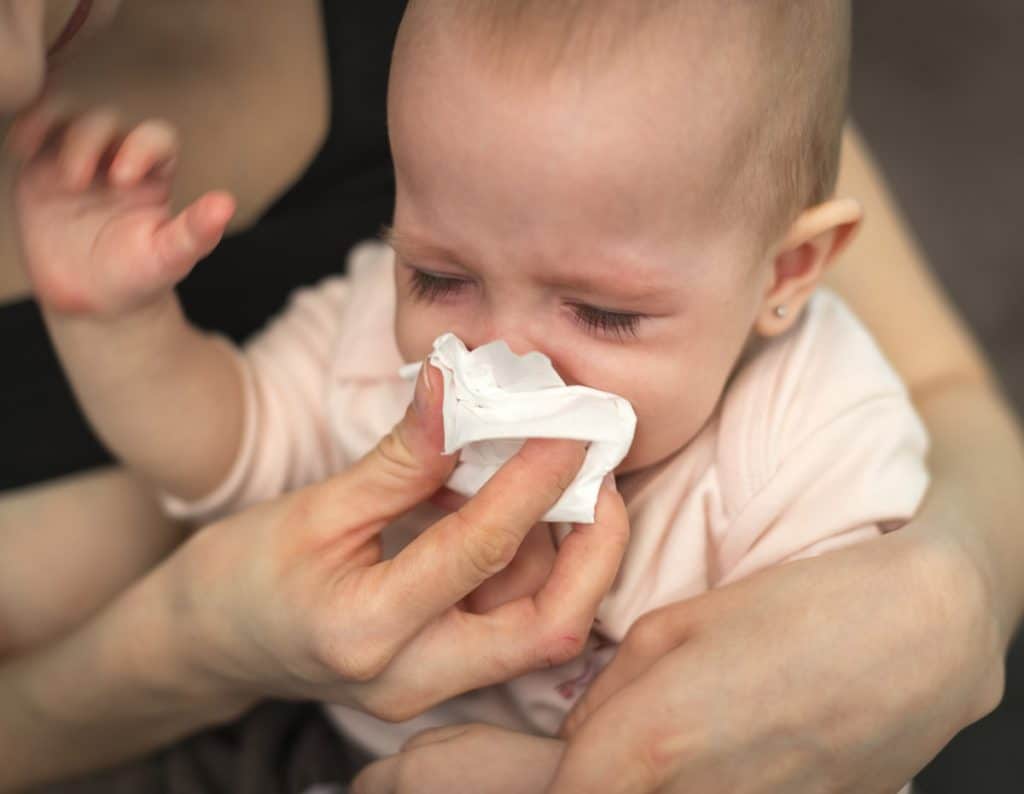When your little one has a cold, this can be a very challenging situation for parents. The younger they are, the harder it is for them to express what they’re going through, so this puts you on a never-ending frenzy of a crying and irritable child. Of course, as a mom, you’d want to be the superhero that removes all of their discomforts—stuffy nose and boogers included.
The downside to a stuffy nose is that it can be more worrisome for your child than a runny nose is. A stuffy nose makes the breathing passage congested, thereby creating difficulties in how a child breathes. Adults and older children may not have a problem with nasal congestion, simply because they know how to blow their nose to clear their nasal passages. For babies and toddlers, however, they need all the assistance they can have from their parents and caregivers.

But, don’t fret as listed below are insights to save the day! These are four of the best ways to treat stuffy nose in babies and toddlers:
In This Article
1. Learn When To See A Doctor
Typically, a stuffy nose or nasal congestion is something you can take care of at home. In a few days’ time, you should see the symptoms start to improve in your baby or toddler. But, before proceeding to home remedies, it’s important to tackle the absolute circumstances when it’s necessary to see your kids ENT in Dallas or wherever you’re from.
Especially once you start to get concerned about your baby’s ability to breathe, then it’s absolutely necessary to see your child’s pediatrician ASAP. Other instances to look out for include the following:
- Your child has bluish tint to their skin, particularly around the lip or nostril area.
- Your child has a breathing rate of more than 60 per minute, and this interferes with their feeding and sleep.
- Your child grunts or moans after taking each breath.
- Your baby is no longer wetting their diaper, starts to vomit, or has a fever.
2. Practice Steam Inhalation
One of the most basic but also most effective home remedies to treat a stuffy nose is to practice steam inhalation. Having your child breathe moist air can help loosen the hard mucus that’s causing the congestion in their nasal passages. There are many ways you can go about with steam inhalation at home, and these include:
- Using a humidifier. This is especially necessary for households that have centralized air conditioning, or if your baby or toddler sleeps in an air-conditioned room. If you opt for a humidifier, however, be sure to set it up according to the manufacturer’s instructions, and clean it regularly to avoid the spreading of mold spores. Otherwise, the accumulation of molds may also contribute to your child’s allergies.
- Run a hot shower. Then, lay a towel on the door as you do so, so you’re able to keep all the steam inside. Sit with your child in the bathroom for a few minutes, before giving them a warm bath.
3. Use A Bulb Suction Device
A bulb suction device, also known as a nasal aspirator, is one of the basic baby gear and equipment you’ll find consistently in baby stores. And, that’s because it really is effective at what it does. For its affordable price, there’s no reason for you not to get a bulb suction device.
As its name implies, it acts as a suction, so you can pump the mucus or snot out of your baby’s stuffy nose. Be sure, however, that you prepare your child for this, so they don’t end up fearing the bulb suction, or you won’t be successful in this pursuit. If you have a toddler, explain to them what it’s for. If you have a baby, you may have to restrain them with a swaddle, just to be sure their head won’t move around too much and their hands won’t be flinging in the air.
4. Saline Drops
On one of your first visits to the ENT or pediatrician, your child’s doctor may have also given you instructions on what saline drops to buy for your baby, just in case they get a stuffy nose. So, this is usually present in many moms’ first aid kits.
Just be sure, however, not to extend the recommended use of saline drops as these can also dry out your child’s nose. In effect, your toddler or baby may become uncomfortable. If you’re unsure, always ask for the recommended frequency of use from your pediatrician or ENT, depending on your child’s age.
Conclusion
As you can see, there are many home remedies you can try out to help clear your child’s stuffy nose. When all else fails, however, always see your child’s pediatrician. When you’ve done all that you can and nothing still seems to work, then you need the assistance of a doctor to ensure your child gets the relief they need. Be it common colds or allergies, it’s important to decongest a stuffy nose as soon as possible. Not only is this for your child’s comfort, but for their safety as well.
Hang in there, mom. Stuffy noses are a part of parenthood, and you’re not alone in those struggles.











